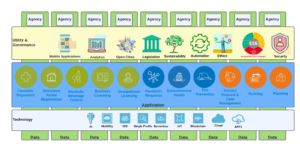This is the 3rd article in a ‘futures’ series authored by Remo Prinsloo, a Lead Solution and Futures Architect for Accela in the Asia Pacific region.

Our world is rapidly changing in its efforts to become more sustainable. In fact, sustainability and ESG (Environment, Social, Governance) is on the top of the agenda for governments and organizations wanting or being seen as doing the “right” thing. In this noble pursuit, however, “greenwashing” has become a common norm for some organizations wanting to be perceived as sustainable without doing the work to actually achieve this badge. Advocating these ideals and advertising these goals is not regulated enough to identify some of these climate change players. It seems for some that in a culture where media and social reputation drives sales and investment, any competitive edge is used, even if that edge is not worth the recycled paper it’s written on. This deceptive and misleading behavior of a few organizations has recently been getting attention in the media and they are called out, or rather, caught out.
This is where ESG comes into practice. Keeping businesses accountable to the commitments they make regarding their employees, the environment, and the communities in which they operate requires education, regulation and competent governance.
The Duty of Regulation
Ethics, morality and goodwill are utopian ideologies that are hard to mandate in the absence of regulation. The human pursuit of money, power and fame is seemingly insatiable, as shared in the Australian Royal Banking Commission’s findings. In this report Kenneth Hayne explains the systemic misconduct in the financial services industry as a result of greed and the pursuit of ever-increasing profit margins. Hayne also identifies the impact of a single bad player in a group and the wider corruption it creates.
Achieving the elusive balance between regulation and innovation is, however, the challenge. Overregulate and there is the risk of smothering innovation and progress. Weakening regulation, however, can have a far greater negative effect, loss of livelihood, loss of wealth, loss of freedoms or loss of life.
As Willis Jenkins warns: “This is the greatest peril of climate change: that the accidental powers of humanity generate problems that exceed our moral imagination and defeat our abilities to take responsibility.”
So how do we regulate without suppression and innovate without destruction?
Ethics
The ideology known as Friedmanism claims that, “The social responsibility of a business is to increase its profits.” Others have blamed this construct for the toxic behavior we experience in our corporations and even governments today. No doubt it permeates organizational management, culture, and even legal obligations to shareholders. Ethics as an underpinning platform in all organizational structures has become vital. Some key aspects from the Haynes report that organizations have been adopting is outlined in John R. Boatright’s book, “Ethics in Finance.” He introduced a framework to guide an organization in establishing a fairer and more ethical environment for its employees, shareholders, customers, and communities:
- Welfare, not only to do no harm but to actively endeavor to relieve suffering when it is observed Duty, acting when required to do so
- Rights, legal obligations dictated by society including freedom and liberty
- Justice, also known as fairness and includes equality and basically giving and receiving what is deserved
- Honesty, loving the truth and making it known
- Dignity, treating others with respect, empathy and love
Regulation as a service
Regulation in the govtech industry manifests as two faces of the same coin: On one side is the regulation and processes and responsibilities of the technology platform itself. Transparency of data from the platform becomes crucial in promoting trust in the wider community and ensures that the government agency has sufficient oversight in the way it conducts its daily business. On the other side of this coin are the regulatory capabilities the platform supports, and its ability to adapt to the fast-changing environment in which we live in and innovate. Keeping up with the relentless pace of innovation and disruption is almost impossible for a single government agency to achieve on its own, requiring expert knowledge in many areas of emerging technologies, including business, law, commerce, finance, education and media.
Govtech platforms differ somewhat in requirements from commercial SaaS platforms because of the need for interoperability between various governmental departments while maintaining data segregation and privacy. As taxpayers, we would want our governments to operate as efficiently as possible and assume that the wisdom and knowledge of one department is automatically adopted by another. This has rarely been the case – with different departments functioning in silos. Useful tools get developed, and re-developed all the time, wasting time and money. A single platform shared across multiple departments can maximize use of tools, minimize cost, increase sustainable usage, while increasing the effectiveness of all the departments involved.

Govtech platforms and open-source regulatory algorithms enable agencies to share artifacts such as reporting templates, AI algorithms, mobile applications, and workflows, as well as tap into expert knowledge distributed throughout the community of agencies while maintaining data privacy and data segregation.
Sustainability
As more tasks become automated and digitized, tools that ensure we achieve the value and consistency we expect are increasingly necessary. For example, transitioning to greener energy sources will require the accurate measuring, distribution and allocation of resources to ensure minimum wastage and maximum utilization. Population growth, food production, housing and the restless human spirit will always intensify consumption of natural resources, thus the interest in technology to make this more efficient and utilize resources responsibly to ensure the preservation of our resources and environment.
Many government agencies are transitioning to cloud infrastructure and SaaS offerings, allowing these services to use resources more efficiently and cost effectively. The cloud creates energy efficiencies, and allows carbon neutral initiatives and green energy to be better utilized and centralized. Microsoft Azure, which powers Accela’s Civic Platform, has been carbon neutral since 2012 and aims to fully use renewable energy by 2025. Cloud providers also continually release new solutions that further save costs and use less energy, and warrant evaluation of new offerings by governmental agencies to ensure the optimum solutions are used.
To date, few providers provide an energy/carbon report as part of the cost analysis of the cloud platforms. Having these sustainability metrics can be used to analyze existing services, programs and algorithms that run in the cloud to determine how energy efficient a government agency is, and then configured or adjusted programmatically to run more efficiently if necessary.
Social Procurement in Government
Social procurement is when an agency or organization uses its combined buying power to drive social and sustainable outcomes for all their procured goods, services and construction, and committing to supporting diversification in suppliers, business partners and employees. “Charity starts at home” represents the empathy, love, sympathy, caring, understanding and action that together create stronger, more resilient communities, and agencies can take this on as a mission to ensure there are no marginalized sectors in their community.
Conclusion
Combining Environment, Social and Governance with regulation is a worthy endeavor to be shared by industry and government. Working together to ensure the responsible consumption of resources while cautiously innovating is vital for a sustainable and ethical society.



